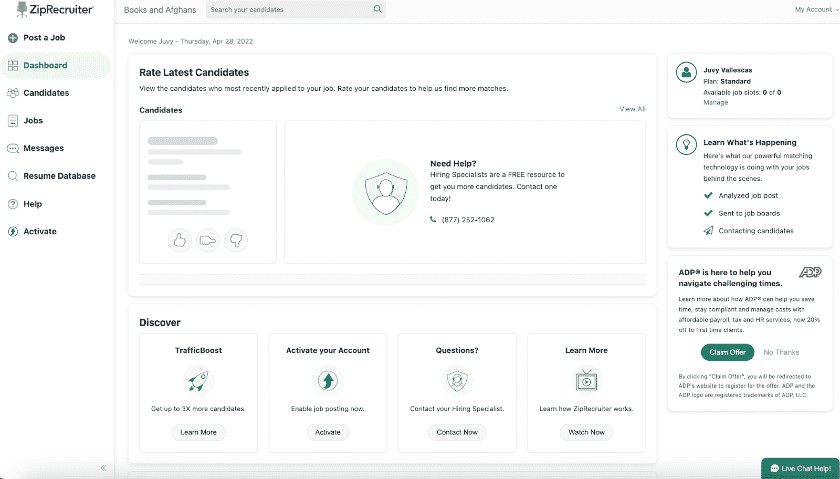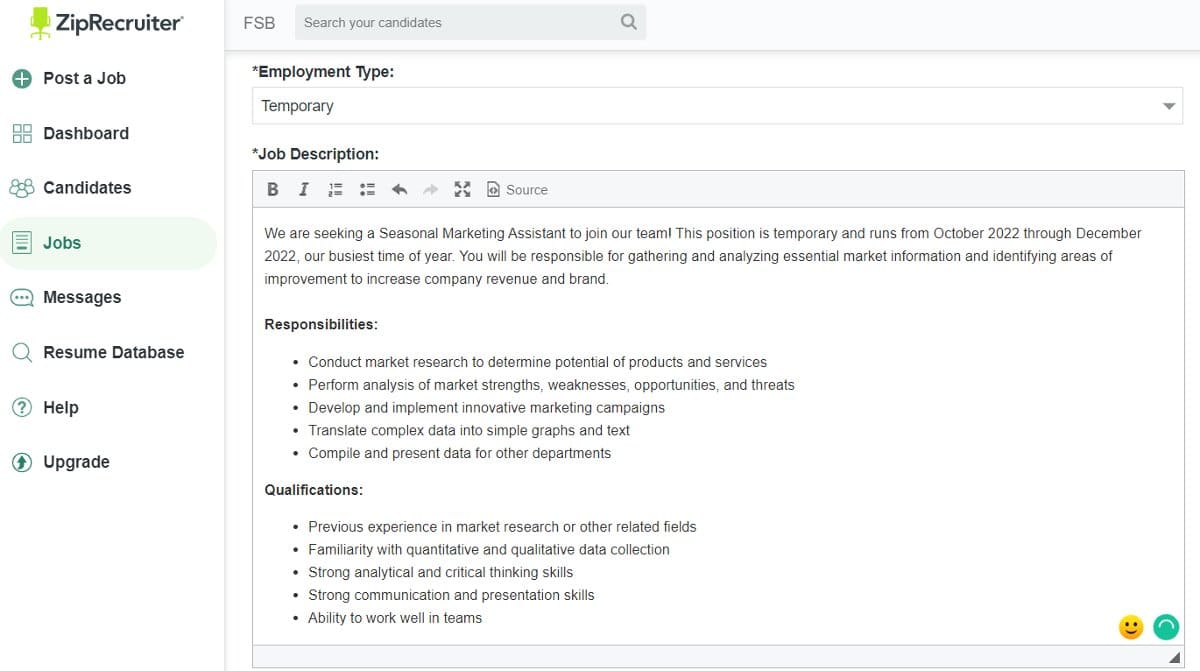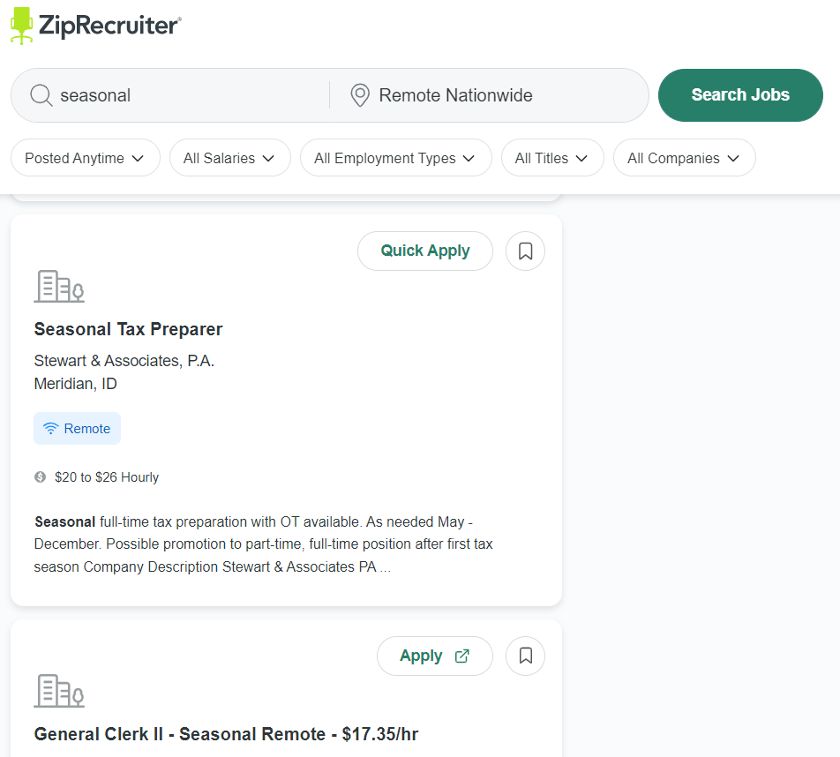Hiring seasonal employees—temporary workers hired when a business typically experiences increased demand—is a strategic move for managing workload during peak periods. In this guide, we’ll show you how to hire seasonal employees, from initiating recruitment early to correctly classifying your seasonal employees. By following our steps, you can attract, recruit, and onboard the right talent, setting your business up for success during your busy seasons.
The easiest way to find the right seasonal hire is through a platform like ZipRecruiter, which streamlines job postings and candidate screenings. Experience its benefits firsthand with a free trial, and gain peace of mind with its proven success in placements. Start your free trial today and make hiring smarter, not harder.
Step 1: Start Recruitment Early
Whether your busy season is in the summer, during the holidays, or when the snow hits at the ski resort, your company has competitors for these seasonal workers. Beginning the hiring process early in your season—two to three months before you wish to fill the role—is essential, as there is not always enough help to go around.
If you wait too late to start the hiring process, you may find yourself short-staffed when you need the support the most. Getting an early start will allow you enough time to review resumes, conduct interviews, and train new employees for the season to come.
Step 2: Develop a Seasonal Employee Pipeline & Give Priority to Returning Candidates
Many employers who hire seasonal employees each year can develop a worker pipeline—where many of the same employees return from season to season. Not only are former employees easy to rehire, but they are already trained and understand their roles.
There are ways to court the seasonal workers you would like to see return to the workplace during seasonal spikes:
- Treat them with a spirit of value: Many seasonal employees are used to feeling disposable since their average time with a company is brief. Be the employer that stands out—and they will return.
- Offer season-ending bonuses: Offering a bonus of any size will be remembered. This rule applies to all industries and businesses, from childcare services and construction companies to food service businesses and holiday retail shops.
- Check in early: As referenced in the previous step, do not wait until your busy season is taking off to touch base with last year’s top-performing seasonal workers. By contacting them early, you give them time to arrange their schedules so they can work for you again year after year.
- Provide special arrangements for top performers: If you have identified seasonal employees that you simply cannot live without, offer the best shifts or a slight raise for their returning experience.

ZipRecruiter will track all candidates within the system and allow you to rate candidates for future use.
Step 3: Create a Clear Job Description Targeting Candidates Looking for Seasonal Work
A clearly written job description that outlines the role and how its seasonal status relates to other types of employment at the company will help attract the right candidates. For help creating a seasonal job description, check our how to write a job description guide—we even provide a customizable template to make it easier for you.
In addition to the specifics of the job, include the following in your job description:
- Seasonally related language: Use relevant keywords, such as “seasonal,” “holiday,” “short term,” and “temporary,” and indicate the job’s timeframe.
- Benefits and perks: Most seasonal jobs do not have conventional healthcare benefits but may have other perks, like product discounts and holiday bonuses. Be upfront with what is and is not offered with the job.
- Skills and requirements: As with any job description, outlining the purpose of the seasonal role, requirements for the job, and the skills needed are all critical to a complete job description.

ZipRecruiter makes creating a job description easy with a guided template.
Step 4: Write a Compelling Job Ad
A job ad—which can be a condensed version of the job description—quickly highlights the position’s duties, location, hours, and pay rate. It should be compelling and stand out from the other ads offering similar opportunities. For help creating a seasonal job ad, check our guide on how to advertise a job.
Take note of these tips to create the best job ad:
- Describe your company
- Clearly outline the timeframe of the position
- Highlight important job responsibilities
- Define the location for the position
- Outline the hours required
- Include the hourly rate
- Include a “how to apply” section

A job ad with ZipRecruiter highlights the necessary attributes of the position and makes applying easy for job seekers.
Step 5: Use a Variety of Recruitment Methods
Knowing where to find seasonal employees can be a challenge, as it may be difficult to find them by only posting on general job sites. Although you can find some seasonal employment ads, job seekers have to work a little harder to ensure they are looking at seasonal jobs and not regular or longer-term positions.
There are specific job boards and other resources you can tap into when looking for seasonal workers. They are not all the same and target different worker groups with different goals, needs, and earning expectations.
- Current employee referrals: To attract new seasonal employees to your organization, consider employee referrals. In many cases, your employees may have acquaintances who may need extra hours during the holidays or throughout the summer (this is when students are temporarily entering the workforce). Just ensure you create a clear employee referral program and cascade it to your employees.
- Mobile platforms: Seasonal workers (especially minors) utilize mobile platforms to locate job opportunities. These workers are typically tech-savvy and primarily use mobile apps and mobile-optimized sites to connect with would-be employers. Our recommended job posting sites for employers can help you tap into this demographic of mobile users.
- College and university job boards: College or university job boards reach thousands of potential candidates. These job boards include all work types, but seasonal work is one of the largest categories.
- Local community: Don’t underestimate the power of local recruitment. Post flyers in community centers, libraries, colleges, or local bulletin boards—even better if you can access these online.
- Networking events: Attend job fairs, industry meetups, or local networking events to meet potential candidates. This can give you an opportunity to sell your business and the benefits of working for you.
- Career pages: Your career page is an important tool during your peak season. Many workers will check company career pages to locate seasonal opportunities ahead of time. If you don’t have one yet, check our guide on creating a career page.

For access to over 100 job boards, consider using a traditional job posting site like ZipRecruiter. It allows you to post jobs in minutes, and you’ll get access to free job description templates.
Step 6: Interview Seasonal Candidates
The interview process is an integral part of hiring seasonal employees. It provides an opportunity to assess a candidate’s suitability for the role, identify potential red flags, and ensure they align with your company’s culture and values.
Even though seasonal workers are temporary, they still contribute significantly to your business during peak seasons. Their performance can impact your operations, customer service, and overall brand reputation. Therefore, it’s crucial to interview seasonal candidates to gauge their skills, attitude, and fit for the role.
When interviewing seasonal candidates, you should ask questions that reveal their ability to handle the job requirements and their commitment to the role. Here are some examples:
- What previous experience do you have that is relevant to this role?
- How do you handle high-pressure situations or busy periods?
- Are you willing to work flexible hours, including weekends and holidays?
- Can you describe a time when you had to deal with a difficult customer? How did you handle it?
- Why are you interested in this seasonal position?
During the interview, be vigilant about potential warning signs that a candidate might not be suitable for the job:
- Lack of availability: If a candidate cannot commit to the required schedule or seems uncertain about their availability, they may not be reliable.
- Negative attitude: A candidate who speaks negatively about past employers or seems disinterested during the interview may carry this negativity into the workplace.
- Inconsistent answers: If a candidate’s responses contradict information on their resume or they seem evasive, it can indicate dishonesty or unreliability.
To optimize your interview process, consider these tips:
- Screening calls: Begin with a phone or video call to screen candidates. This allows you to quickly assess their suitability before investing time in a face-to-face interview.
- Structured Interviews: Use a standardized list of questions for all candidates to ensure fairness and make comparisons easier.
- Practical assessments: Depending on the role, consider incorporating a practical task into the interview to assess a candidate’s skills firsthand.
- Multiple interviewers: If possible, have more than one person interview the candidate. This can provide multiple perspectives and reduce individual bias. Check our guide to conducting panel interviews for more information on this process.
Step 7: Onboard the Seasonal New Hires
Onboarding seasonal employees is just as important as onboarding your regular employees. It provides them with the knowledge and skills to successfully perform their job. Develop a simple, easy-to-maintain program that onboards your seasonal workers quickly and efficiently.
Some tips to make things go smoothly include:
- Prepare new hire paperwork: Create a new hire checklist to ensure you have all required paperwork before or on their first day.
- Orientation session: Start with an orientation session to introduce your seasonal employees to your business. This could include an overview of your company’s values, mission, culture, and a tour of the workplace. Including returning seasonal employees is a great way to establish relationships with new employees and utilize a buddy system.
- Adjust workers’ compensation: Do not forget to adjust your workers’ compensation coverage to accommodate seasonal workers.
- Outline expectations: Be sure to explain the position and train your seasonal employees to be successful at their jobs.
Step 8: Classify Seasonal Employees Properly
Classifying your seasonal employees is as important as classifying regular employees properly. The Department of Labor requires proper and accurate classification, whether seasonal, temporary, or regular employees.
For example, you do not want to classify a nonexempt seasonal position as exempt, which generally exempts the employee within the role from earning overtime. Most seasonal employees fall under the category of nonexempt and are eligible for overtime because they are generally part-time employees. However, some will be considered exempt by the DOL, especially if they are working full time during their seasonal employment or your business only operates during certain times of the year.
These may include:
- Administrative assistants
- Tax preparers
- Amusement park workers
- Recreational workers (i.e., golf course, swimming pool, summer camp, etc.)
Keep in mind that when hiring minors for seasonal positions, specific rules must be followed, such as working hours and ineligibility to work hazardous jobs.
Why Companies Use Seasonal Employees
Seasonal workers are just one type of employee and can provide a viable solution for businesses to manage increased demand during certain times of the year. Here are several reasons why companies turn to seasonal hiring:
- Cost-effective: Hiring full-time employees to handle temporary increases in workload isn’t always the most economical decision. Seasonal employees allow businesses to scale temporarily without the long-term financial commitment of full-time staff.
- Flexibility: Employing seasonal employees allows businesses to adapt their workforce size to meet their needs at different times throughout the year. This flexibility means during busy periods, they can increase their workforce, and when things slow down, they can easily reduce their staff count.
- Increased productivity: Seasonal employees can take the pressure off the regular staff during peak periods, reducing overwork and maintaining morale. They help ensure the business continues to operate efficiently even during high-demand seasons.
- Meeting high demand: Seasonal workers help businesses meet increased demand during busy times of the year without incurring excess labor costs. They ensure the company can handle the extra workload effectively.
Many industries commonly utilize seasonal employees each year. Examples include:
- Retail/sales
- Childcare
- Personal care and services
- Food services
- General office/administrative
- Agricultural
- Seafood processing
- Warehousing, transportation, utilities
- Federal government
- Construction
- Landscaping
- Tourism
- Ski resorts
- Swimming pools
- Summer camps
Typically, seasonal employees are hired for a few months at a time. This planned fluctuation of employment results in lowered payroll costs, reduced insurance premiums for the business, and an overall reduction in liability for things like workers’ compensation and benefits.
Best Practices for Hiring Seasonal Employees
When hiring seasonal employees, strategic planning and a keen eye for detail can set you up for success.
- Start Recruitment Processes Early: Start the recruitment process as soon as possible and work to retain your top performers for next season. Offer them a role before this season ends and consider paying a bonus to further entice them.
- Keep Constant Communication with Excellent Seasonal Employees: Stay connected with workers even after they’ve left. Send them updates about your company and inform them early of upcoming seasonal opportunities. Even if they’re no longer interested, they may know someone who would be a good fit. Remember, referrals make the best hires.
- Watch Out for the Red Flags: For a returning worker, it’s not uncommon to have one bad experience, but if you’re encountering multiple issues with them over more than one season, it might be time to move on. The same is true of a new seasonal employee who’s had multiple short-term roles and left on bad terms. Those might be workers to avoid.
Hiring Seasonal Employees Frequently Asked Questions (FAQs)
Seasonal employment can lead to high turnover, increased training costs, and inconsistency in staff performance. It may also result in low employee engagement and retention issues, making it difficult to build a reliable, long-term team. Managing schedules and compliance with labor and employment laws can also be more complex.
Effective handling of seasonal employees involves clear onboarding, proper training, and setting expectations upfront. It’s also important to maintain open communication, offer flexible scheduling, and recognize good performance to encourage return workers for future seasons.
Seasonal hiring refers to employing workers for a limited period of time, typically to meet increased demand during busy times of the year, like holidays or peak seasons. Seasonal employees work on a temporary basis and are often hired in roles for retail, tourism, and agriculture.
In New York State, a seasonal employee works only for a specific, limited time during the year. These employees may not qualify for benefits, depending on the duration of their employment.
The minimum wage for seasonal workers in New York State is the same as regular workers, $15 per hour. However, it’s $16 per hour in New York City, Long Island, and Westchester.
Seasonal employees are typically classified as nonexempt, since they’re employed for a short period of time and usually paid by the hour. They typically don’t receive benefits and their position often has a firm end date. However, ensure that it complies with the classifications of the DOL for full compliance.
The IRS defines a seasonal employee as someone who works six months or less during the year, usually tied to a specific season. Seasonal employees are not considered full-time employees.
Bottom Line
Hiring seasonal employees can greatly enhance your ability to harvest and process products and staff for heavier workloads during your busiest time of year. Knowing how to find seasonal employees and how best to onboard them can give your company an advantage over your competition.
Start early, keep in contact with top seasonal talent, and make sure you have all your bases covered before putting people to work—and you will make the most out of your busiest and most profitable time of year.